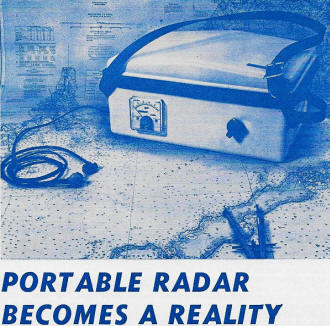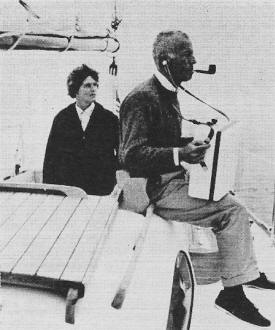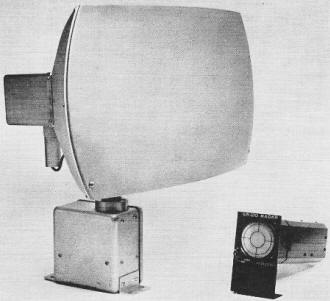|
July 1971 Popular Electronics
 Table of Contents Table of Contents
Wax nostalgic about and learn from the history of early electronics. See articles
from
Popular Electronics,
published October 1954 - April 1985. All copyrights are hereby acknowledged.
|
Your idea of a usable portable
radar probably does not include one that requires you to manually point it at your
surroundings and listen through a set of earphones for a tone's volume and pitch
to estimate distance to the target (or you can use the small analog meter on the
case. That was considered a technological breakthrough in 1971, and Kimball Product
Company's "Whistler" was the star. It only cost $595 ($3,743 in 2019 dollars) for the capability. The
trade name "Whistler" is very well known today, but I could not find any information
relating it to its namesake in this article. There is a
Kimball Electronics,
but their About Us page is down at this time. Most likely, though, it is
The Whistler
Group that is the progenitor of the radar unit mentioned here. Today, they have
an extensive line of
portable radar units for marine, automotive,
aviation, and other applications.
Portable Radar Becomes a Reality
 Two New Sets for the Boat Owner Two New Sets for the Boat Owner
By Richard Humphrey
Many times in the past, I have flapped out of the office, climbed into my High
Dither and gone screaming across the countryside to track down the latest rumor
of a "portable" or "hand-held" radar. And every time, I was disappointed. However,
on my latest try, I think I found not one, but two. What's more they both work better,
in some respects, than their manufacturers claim.
The first (shown in the photo above) is truly a hand-held radar. Called the Whistler,"
it is 6" x 10" x 13", weighs under seven pounds and resembles a thick briefcase.
The case is made of high impact plastic which is "easily cleaned with soap and water"
and is waterproofed (floats if dropped overboard). Aimed squarely at the pleasure
boat market, Whistler is priced at $595. Kimball Products Company claims a two-mile
maximum range for the Whistler and a minimum range of 50 feet. When I worked with
the unit, I copied a shoreline nearly three miles away. It wasn't possible to get
a reading on small buoys at this distance, but I did get sharp returns from them
at 2 miles and 2.3 miles. We also "read" large wooden pilings at approximately 35
feet; so, as far as range is concerned, Whistler performs better than advertised.
The 70-milliwatt output feeds a parabolic antenna with a 3° horizontal and 10°
vertical beamwidth. We found this sharp enough to give good target separation throughout
the entire range (distinct echoes from a nun buoy and can buoy marking a channel
50 feet wide at a distance of 1.7 miles, for instance).

The Whistler is being used here by Roger Merrill of Kimball Products.
There is one knob for on/off control and the meter is calibrated in tenths of a
mile. Neck strap provides safety in handling.
Purists will miss the cathode ray tube display of conventional radar. Whistler,
however, is intended to take over where traditional radar leaves off: in the two-mile-and-under
range. To use the Whistler radar, you connect the power cable to either the boat's
12-volt dc supply (power consumption, 0.5 A) or to a rechargeable NiCad TV battery,
plug in the earphones, turn the unit on and adjust the sensitivity knob until you
get a good "sky return" while aiming the Whistler upwards. Then merely sweep the
horizon slowly until you hear a definite change in intensity and pitch. (An adjustable
neck strap is provided.) Then you've found a target. A quick comparison with the
boat's compass will give you the relative bearing. Distance can either be "guesstimated"
from the pitch of the echo - the farther away the target, the higher the pitch;
the closer the target, the lower the pitch - or by reading directly from the distance
meter. On our prototype, the meter read only to one mile, and it wasn't properly
calibrated. We found an error of approximately 0.2 mile. (A lighted buoy 1/2 mile
away showed 0.3 mile on the meter.) Despite these minor shortcomings, I read the
surroundings (using a chart of the area) as quickly and as accurately as I could
have with conventional radar. In fact, it was better, since conventional radar begins
to get myopic at minimum ranges.
Along more conventional lines is the Bonzer SR-20 small boat radar made by Bonzer,
Inc. While not "hand-held" like the Whistler, the SR-20 is small enough and light
enough to be taken off the boat easily and carried home under one arm. The transceiver/antenna
is 12" X 24"; the rotator 6" X 6" X 4"; the display unit (a 3" CRT) 3 1/4" X 3 1/4"
X 10"; and the total weight of all three is 13 pounds. Simple to operate, the SR-20
has just two controls: an on/off sensitivity switch and a range switch (2500, 250
and 50 yards). Maximum range is 2500 yards, minimum 30 feet. The Bonzer (an Australian
word meaning "very good" if you're interested) isn't choosy about its power source;
anything between 10 and 35 volts dc keeps it happy. It draws approximately 2 amperes;
the peak power is 10 watts; and the antenna rotates at 20 rpm. A price tag of $1495
makes the Bonzer SR-20 the least expensive conventional radar on the market today.

Though it is a more or less conventional radar, the Bonzer SR-20
is still small enough to be taken off the boat for safe keeping. It has an on/off
sensitivity control and a range switch. Maximum range is 2500 yards; minimum 30
feet.
Installation is also less - around $150 would be a good ballpark figure - than
other radars which are generally $400 to $450. As a matter of fact, the average
boat owner could probably do the physical installation himself: make two connections
for power; install the transceiver/antenna and rotator units on a mast, pole or
cabin top; plug in the 20' pre-wired connecting cable which comes with the radar;
and call in an FCC-licensed technician to check the installation for a minimum fee.
Both the Bonzer and the Whistler have a common ancestor: the radar altimeter
which is standard equipment on most aircraft. The Bonzer operates at 5500 MHz while
the Whistler is on the 14,000-14,050-MHz band recently authorized by the FCC for
continuous-wave FM small-boat radar. (The conventional "X-Band" marine radar operates
at 9,000 MHz.)
Both companies - Kimball Products Company which makes the Whistler and Bonzer,
Inc. which makes the SR-20 - will be concentrating on this year's pleasure boating
season. Kimball said it would be in "limited production" by June, while Bonzer claimed
"delivery in March."
Posted June 18, 2019
|












